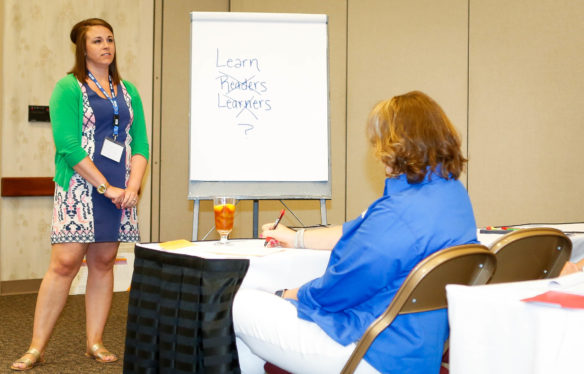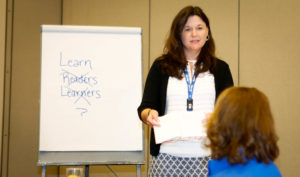
Marion County High School English teacher Amy Mattingly collaborated with a social studies teacher to have her students binge on texts related to their AP Human Geography class. Mattingly presented the idea at the TALK conference in Covington.
Photo by Brenna R. Kelly, June 13, 2016.
By Brenna R. Kelly
Brenna.kelly@education.ky.gov
Who doesn’t love a good binge-watching session? Just one more episode of a favorite TV show can quickly slip into a day spent plowing through the entire series.
Amy Mattingly, English/language arts teacher at Marion County High School, says she’s guilty.
“I put my My Little Pony headphones on that I steal from my child and I binge watch,” she said.
And she’s not alone. Sixty-one percent of people who stream TV said they binge watch regularly, according to a 2013 survey by Harris Interactive. And 73 percent of streamers said they feel good about binge watching.
So Mattingly decided to take the idea of bingeing to the classroom, but instead of binge watching, her students would be binge learning.
“It’s our job, no matter if we teach English, math or social studies, to make them readers and writers,” she said. “Because when you read you learn, when you write you learn and it doesn’t matter what we teach. It’s our job.”
Mattingly worked with an Advanced Placement (AP) Human Geography teacher Jamie Brown to amplify the content of an agriculture unit by using articles about agriculture in her English class.

Angie Gunter, literacy specialist at the Green River Regional Educational Cooperative, explains how she allowed her students to binge on a personal interest by creating a blog.
Photo by Brenna R. Kelly, June 13, 2016.
Mattingly and Angie Gunter, a former AP English teacher at Daviess County High School, explained the experiment and the importance teaching high school students literacy skills at the TALK Conference this summer in Covington.
“The idea is that if you string a bunch texts about a similar content, it helps students build knowledge,” said Gunter, now a literacy specialist at the Green River Regional Educational Cooperative. “The more you can add different texts about a topic, it creates knowledge and at the same time builds their reading skills.”
Before Mattingly began the cross-content experiment, she examined the agriculture unit and AP test. Then she searched for articles, videos, graphics or anything else that would complement the content.
As she selected articles for the students, Mattingly checked the Lexile level, a measure of the text’s difficulty, to make sure students were getting complex texts.
“I didn’t want to bring in anything that would be below the level of the students,” she said.
Studies have shown that students’ reading skills do not improve if they are consistently reading at their level, Gunter said. Students need to be challenged with more difficult texts.
The ability to read and understand a complex text was the biggest factor in determining whether students met the college readiness reading benchmark on the ACT, according to ACT’s 2006 report “Reading Between the Lines: What the ACT Reveals About College Readiness in Reading.”
“Performance on complex texts is the clearest differentiator in reading between students who are likely to be ready for college and those who are not,” the report stated. “And this is true for both genders, all racial/ethnic groups, and all family income levels.”
For six weeks, students in Mattingly’s English class worked with the texts, graphics and videos about agriculture. She taught the students several reading strategies, such as reading for the main idea, reading with paraphrasing, reading to pick out words they didn’t know, reading for imagery, using graphic organizers and others.
“I wanted to make sure that they knew how to attack a text,” she said. “I wanted to model and hope that it would carry on to the next class – and that’s the idea of bingeing. I wanted the things they did in my class to carry over into social studies or into their science class or math class.”
When the students were reading an article in the Human Geography class, Mattingly would use the text for vocabulary by having her students find the definition, part of speech, synonym and antonym.
“There were plenty of words they didn’t know,” she said.
In addition to the texts, Mattingly used videos and informational graphics to supplement the content. But students didn’t just watch the videos and look at the graphics, they had to write about them.
“I wanted my class to amplify what was going on in other class,” Mattingly said. “I feel like that’s my job as the English teacher. I’m supposed to make them more successful in their other classes.”
And it worked, she said. On the multiple choice section of the test, her students’ scores skyrocketed over the scores from the previous year’s class, Mattingly said.
“The free response went up a few points, but it’s still a success,” she said.
Only half of Brown’s students were in Mattingly’s English class, but of the students who took the AP Human Geography test, 50 percent scored in highest quarter of all testers globally on the agriculture free-response question, Brown said.
“Students really benefit from this,” she said, “especially in an AP course where they are expected to have in-depth knowledge for a comprehensive national exam.”
Mattingly also compared her students’ results on the binge-reading agriculture unit test to a religion unit test – which didn’t use the binge-reading idea – in the same class. The average score on the free-response section of the agriculture test increased 8 points over the religion class, she said.
“I marched on down to the office and said, ‘Look what we did,’” she said.
When students are discussing the same vocabulary cross-curricular and reading a variety of articles in both courses, that truly enriches their knowledge of subjects. Students are only going to benefit from this, especially in an AP course where they are expected to have in-depth knowledge for a comprehensive national exam.
Gunter’s students also binge learned, but instead of bingeing on required content for a class, they binged on a personal interest. The students each picked topic they wanted to learn about or were passionate about, Gunter said. Students then binged on the topic, finding articles, videos or websites.
Students had to keep a blog of their work and list each new thing they learned, she said. The text the students read had to be high Lexile level, she said.
“I send them to Readworks, The Atlantic, the New Yorker,” she said.
Some students who were in an AP U.S. history class made their blog about history, some made theirs about writing college admissions essays. Other projects had nothing to do with school – such as the Zika virus.
Mattingly said any subject area teacher could help their students binge.
“It’s my hope that in really good classrooms, you look at an activity like this and it’s binge learning. You don’t know if it’s a science class or social studies class or an English class,” she said. “I think in a perfect world, you wouldn’t be able to tell.”
MORE INFO …
Amy Mattingly amylois.mattingly@gmail.com
Angie Gunter angie.gunter@grrec.org






Leave A Comment